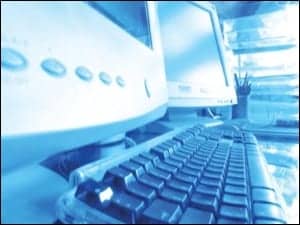
Many therapists are considering the implementation of electronic medical record (EMR) solutions, but hesitate on making the purchase because they aren’t sure exactly how the technology will help their practice.
Our practice had the same concern initially, so we thoroughly evaluated the areas where an EMR could improve our business. It was quickly apparent that paper-based processes had a stranglehold on our practice. We suffered from many of the challenges other practices experience, such as: misplaced patient records; incomplete, untimely documentation impacting the billing process or regulatory compliance; productivity and financial performance data that was several months old by the time it was compiledWith the industry steadily moving toward widespread adoption of EMRs, we wanted to get ahead of the curve. Our facility, HealthPoint Rehab, which is affiliated with Southeast Hospital, handles about 33,600 patient visits annually out of two outpatient rehabilitation centers located in Cape Girardeau and Jackson, Mo.
There are numerous EMRs designed for physician practice specialties, but few that address the specific needs of rehab centers. We found a system designed to accommodate our team of 25 therapists engaged in physical, occupational, speech, and specialty therapies. Our system automates workflow for cross-discipline scheduling, referrals, insurance authorizations, clinical documentation, charges, and more. It includes Health Level 7 (HL7) interfaces to our hospital information system for effortless exchange of data. Most importantly, it supports our efforts to comply with professional standards while running an efficient business.
After a comprehensive system selection process, we implemented a software system in January 2009. The following information details how the technology has helped our organization over the past 2 years.
The biggest benefit we immediately noticed was the timely documentation of patient treatments. We have desktop computers installed within private exam rooms and laptop carts in our open gym spaces. Most of our therapists complete the treatment notes during the patient visit, while others finish after the visit.
In contrast, it took us much longer to get our initial evaluation paperwork to the physicians’ offices when we relied on dictation, transcription, and snail mail. We used to employ a full-time transcriptionist, but we have since eliminated the position and use the system’s faxing software to electronically fax our documentation to the physicians.
The structure of our daily notes within the software system has allowed our therapists to document procedures in a very clean and concise format. Another benefit is that our software system can ensure compliance with insurance regulations and therapy standards. During the documentation process, the system alerts therapists if they do not complete sections of the note that are necessary to comply with requirements from Medicare and The Joint Commission.
Using the EMR has helped us improve our billing process. Since charts are electronic and always available to the billing specialists when they need them, we complete our billing in a much more timely manner. We no longer waste time searching for the paper chart.
Unlike most EMRs, our rehab-specific solution has therapy-based billing capabilities built right into it. Correct coding initiative (CCI) edits built into the system help prevent errors that can result in returned claims or rejections from payors. The latest CCI edit table is automatically downloaded into the charge table, so we are always working from the most current version. Our system automatically reviews charges as they are being entered and alerts users if charges are improperly grouped or are missing modifiers. Using the system gives us the confidence that we are doing our billing correctly the first time, so we don’t have to worry about rebilling later in order to fix errors.
Further assisting our billing efforts is an interface that connects the system to the Meditech hospital information system at Southeast Missouri Hospital. The interface allows the systems to exchange information for billing and results, as well as admission, discharge, and transfer data. The result is a reduction in duplicate data entry.

TRACKING CAPABILITIES
The tracking capabilities of the EMR also help with compliance, especially when it comes to ensuring that physicians sign plans of care following initial patient evaluations. The system’s reporting capabilities enable therapists and front-office workers to easily view all plans of care that have not been signed by physicians, which helps accelerate follow-ups. And in cases where physician signatures have not been obtained, it tracks the number of times the plan of care was faxed by the system to a physician for signature. This tracking capability helps rehab clinics demonstrate their due diligence in trying to obtain signatures, which is Medicare compliant.
Prescriptions for therapy are also tracked. Upon receiving a physician’s prescription for therapy, it is entered into the system along with the number of visits that are prescribed or allowed by insurance. It also reports patients who have prescriptions that are about to expire, so the front-office can ensure we continue to treat patients with a current prescription.
A simple-to-use ad hoc analysis tool enables us to analyze practice trends, develop universal metrics, measure long-term changes, and gather operational decision-support data. Using the EMR’s analytics package, we have been able to analyze cancellation rates by patient type, determine our top referral sources by physician or physician group practice, track the number and type of CPT code charges, as well as proactively monitor staff productivity.
For example, by using the analytics module, we discovered that pediatric speech patients had the highest number of visit cancellations. Each cancellation negatively impacts our revenue and therapist productivity, so we developed new cancellation policies—applied to all patient types—to help curb the problem. By making patients aware of the new policy, we have been able to decrease our cancellation rate from 18% to 13%.
We also use the analytics module to track therapist productivity based on hours worked and units billed. In the past, we had one of our secretaries compile data to measure therapist productivity, but the process was cumbersome, and results were not available for 2 to 3 months after the time frame measured. Now, productivity is calculated weekly, so therapists can proactively monitor their productivity, which has been a wonderful management tool.
Another area we monitor with the analytics module is tracking referral sources. We can see exactly which physicians and physician clinics refer the most patients to us, which guides us in building relationships and growing our business.
The productivity of our front-office has been greatly improved by using the new system’s electronic scheduling capabilities. Now, scheduling is easy; as information can be clicked, dragged, copied, and pasted rather than entered manually. Also, scheduling multiple visits can be done all at once instead of creating individual appointments.
Front-office productivity is further enhanced by the system’s automated paging capabilities. Upon patient check-in, the system automatically sends an alphanumeric page to the corresponding therapist to let them know that the patient has arrived. Previously, the receptionist manually dialed the therapist’s numeric pager and during busy periods, it would be several minutes following the patient’s arrival before the secretary was able to send the page. In a business that bills based on time and units, a 3- to 5-minute delay can be the difference of billing an additional unit of service. In that regard, something as simple as automated paging may eventually lead to increases in revenue for us.
The EMR we selected has complemented our workflows and helped our practice improve productivity and documentation.
The most vital component to our successful EMR usage is that we selected a solution designed to operate in our business environment. The system’s rehab-specific capabilities allow our practice to automate the processes that matter most to our business. After using the solution for nearly 2 years, we can’t imagine doing our jobs without it.
Andrea Marchi, PT, MBA, CSCS, is the rehab manager at Southeast Missouri Hospital, HealthPoint Rehab, Cape Girardeau, Mo. For more information, contact .





